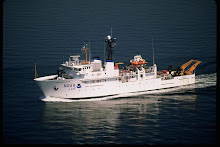 Bronc Buoy Day! By 8 this morning ship time we were running out the Nielspin and slapping on the fairings from the recovery yesterday.Some of these were pretty clean, but the majority of them, the ones that the teachers got to help with were pretty slimy and even
Bronc Buoy Day! By 8 this morning ship time we were running out the Nielspin and slapping on the fairings from the recovery yesterday.Some of these were pretty clean, but the majority of them, the ones that the teachers got to help with were pretty slimy and even  had barnacles stuck to them.The fairings are added to help the reduce shake on the wire that can be produced by currents close to the equator.
had barnacles stuck to them.The fairings are added to help the reduce shake on the wire that can be produced by currents close to the equator.




We put these airfoil shaped fairings on the first 250 meters, after that it was smooth sailing. Because the Bronc-Bobcat buoy at 0: 155W is a TAO-CO2 buoy it needed a little extra
weight on the anchor, 6200 pounds of steel.
Once the anchor was off the fantail and sinking we noticed that there was a ship close to the location of the buoy. The science crew commented that this must be a new record for the fishermen finding one of the buoys. It seems that fishermen love the TAO buoys since they attract fish. One of the scientists said, “A buoy for these guys is like having your own private fishing hole”. It will be interesting to see if this ship leaves, or just steams away and waits for us to be clear of the area and then comes back.

Around 12:15 today, actually Rick and Art were just finishing up lunch when the call came from Survey, “Teacher’s at Sea report to the CTD deck”. The first order of business was to lower an Argo buoy over the side of the ship and then to release the buoy using a quick release.According the home page for Argo

These buoys are unique because the sink to between 1000 and 2000 meters and then on regular intervals, generally 10 days the Argo returns to the surface to transmit and the data it has collected. This allows, for the first time, continuous monitoring of the temperature, salinity, and velocity of the upper ocean, with all data being relayed and made publicly available within hours after collection.
 Once the Argo was on its own a call was made to the bridge for the crew to help with the deployment of the Bronc Buoy. This AOML drifter’s data will be available in a few days from the Adopt-A-Drifter website. It will be interesting to follow the Bronc Buoy and see where it goes over the next several years.
Once the Argo was on its own a call was made to the bridge for the crew to help with the deployment of the Bronc Buoy. This AOML drifter’s data will be available in a few days from the Adopt-A-Drifter website. It will be interesting to follow the Bronc Buoy and see where it goes over the next several years.

Our afternoon will be spent sailing south, in the Southern Hemisphere for the first time this trip and devoted to teardown of the old 0: 155W buoy and set-up of our next buoy.


No comments:
Post a Comment